Page 57 of 89
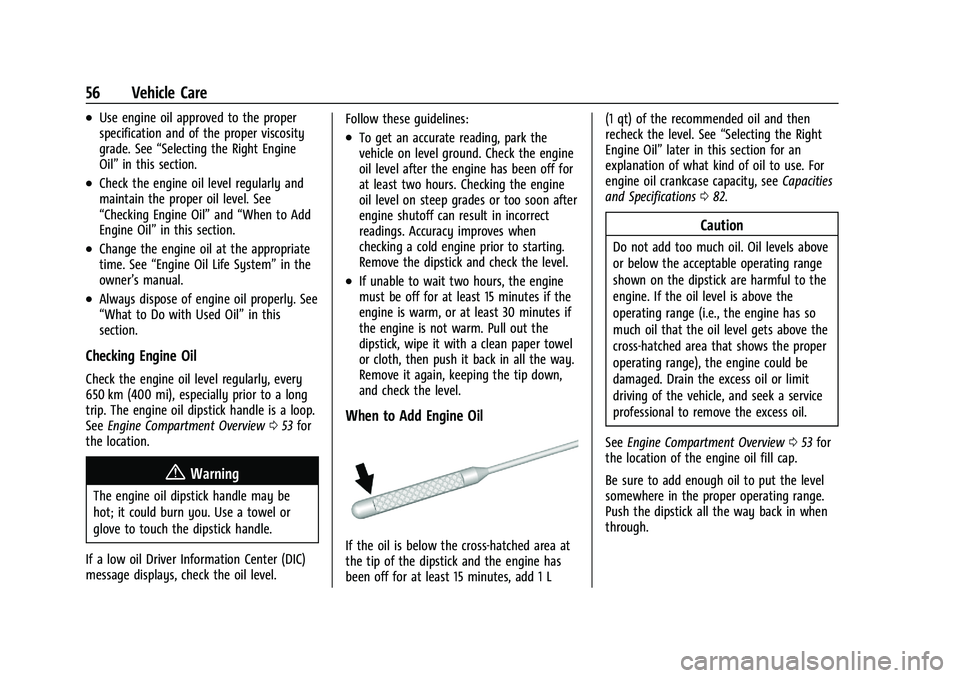
Chevrolet/GMC 2.8L Duramax Diesel Engine Supplement (GMNA-Localizing-
U.S./Canada-14465442) - 2021 - CRC - 2/3/20
56 Vehicle Care
.Use engine oil approved to the proper
specification and of the proper viscosity
grade. See“Selecting the Right Engine
Oil” in this section.
.Check the engine oil level regularly and
maintain the proper oil level. See
“Checking Engine Oil” and“When to Add
Engine Oil” in this section.
.Change the engine oil at the appropriate
time. See“Engine Oil Life System” in the
owner’s manual.
.Always dispose of engine oil properly. See
“What to Do with Used Oil” in this
section.
Checking Engine Oil
Check the engine oil level regularly, every
650 km (400 mi), especially prior to a long
trip. The engine oil dipstick handle is a loop.
See Engine Compartment Overview 053 for
the location.
{Warning
The engine oil dipstick handle may be
hot; it could burn you. Use a towel or
glove to touch the dipstick handle.
If a low oil Driver Information Center (DIC)
message displays, check the oil level. Follow these guidelines:
.To get an accurate reading, park the
vehicle on level ground. Check the engine
oil level after the engine has been off for
at least two hours. Checking the engine
oil level on steep grades or too soon after
engine shutoff can result in incorrect
readings. Accuracy improves when
checking a cold engine prior to starting.
Remove the dipstick and check the level.
.If unable to wait two hours, the engine
must be off for at least 15 minutes if the
engine is warm, or at least 30 minutes if
the engine is not warm. Pull out the
dipstick, wipe it with a clean paper towel
or cloth, then push it back in all the way.
Remove it again, keeping the tip down,
and check the level.
When to Add Engine Oil
If the oil is below the cross-hatched area at
the tip of the dipstick and the engine has
been off for at least 15 minutes, add 1 L(1 qt) of the recommended oil and then
recheck the level. See
“Selecting the Right
Engine Oil” later in this section for an
explanation of what kind of oil to use. For
engine oil crankcase capacity, see Capacities
and Specifications 082.
Caution
Do not add too much oil. Oil levels above
or below the acceptable operating range
shown on the dipstick are harmful to the
engine. If the oil level is above the
operating range (i.e., the engine has so
much oil that the oil level gets above the
cross-hatched area that shows the proper
operating range), the engine could be
damaged. Drain the excess oil or limit
driving of the vehicle, and seek a service
professional to remove the excess oil.
See Engine Compartment Overview 053 for
the location of the engine oil fill cap.
Be sure to add enough oil to put the level
somewhere in the proper operating range.
Push the dipstick all the way back in when
through.
Page 58 of 89
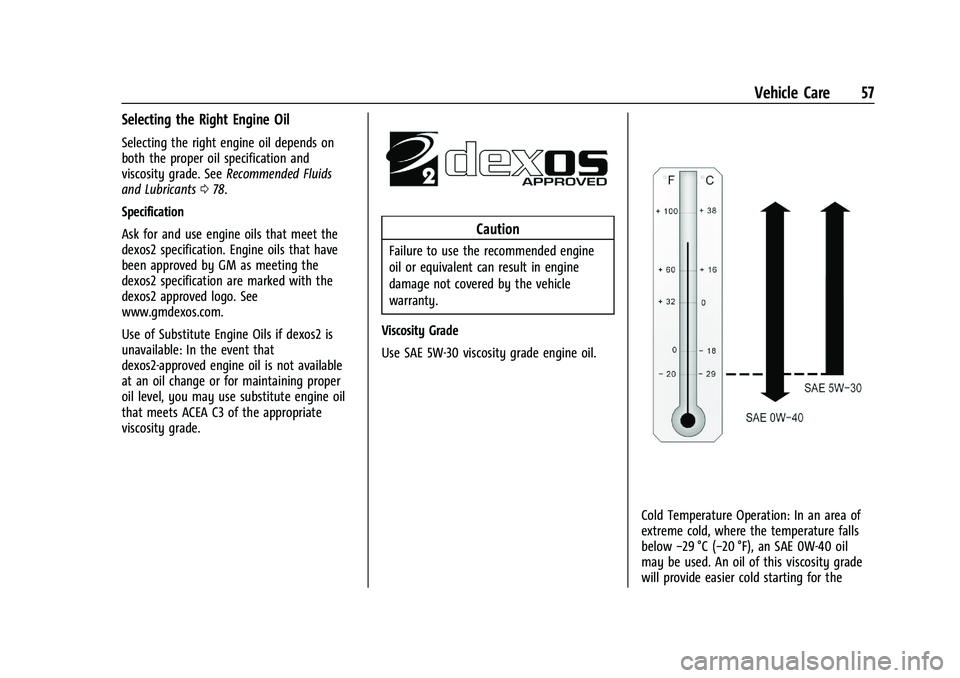
Chevrolet/GMC 2.8L Duramax Diesel Engine Supplement (GMNA-Localizing-
U.S./Canada-14465442) - 2021 - CRC - 2/3/20
Vehicle Care 57
Selecting the Right Engine Oil
Selecting the right engine oil depends on
both the proper oil specification and
viscosity grade. SeeRecommended Fluids
and Lubricants 078.
Specification
Ask for and use engine oils that meet the
dexos2 specification. Engine oils that have
been approved by GM as meeting the
dexos2 specification are marked with the
dexos2 approved logo. See
www.gmdexos.com.
Use of Substitute Engine Oils if dexos2 is
unavailable: In the event that
dexos2-approved engine oil is not available
at an oil change or for maintaining proper
oil level, you may use substitute engine oil
that meets ACEA C3 of the appropriate
viscosity grade.
Caution
Failure to use the recommended engine
oil or equivalent can result in engine
damage not covered by the vehicle
warranty.
Viscosity Grade
Use SAE 5W-30 viscosity grade engine oil.
Cold Temperature Operation: In an area of
extreme cold, where the temperature falls
below −29 °C (−20 °F), an SAE 0W-40 oil
may be used. An oil of this viscosity grade
will provide easier cold starting for the
Page 59 of 89

Chevrolet/GMC 2.8L Duramax Diesel Engine Supplement (GMNA-Localizing-
U.S./Canada-14465442) - 2021 - CRC - 2/3/20
58 Vehicle Care
engine at extremely low temperatures.
When selecting an oil of the appropriate
viscosity grade, it is recommended to select
an oil of the correct specification. See
“Specification”earlier in this section.
Engine Oil Additives/Engine Oil Flushes
Do not add anything to the oil. The
recommended oils meeting the dexos2
specification are all that is needed for good
performance and engine protection.
Engine oil system flushes are not
recommended and could cause engine
damage not covered by the vehicle
warranty.
What to Do with Used Oil
Used engine oil contains certain elements
that can be unhealthy for your skin and
could even cause cancer. Do not let used oil
stay on your skin for very long. Clean your
skin and nails with soap and water, or a
good hand cleaner. Wash or properly
dispose of clothing or rags containing used
engine oil. See the manufacturer's warnings
about the use and disposal of oil products.
Used oil can be a threat to the environment.
If you change your own oil, be sure to drain
all the oil from the filter before disposal. Never dispose of oil by putting it in the
trash or pouring it on the ground, into
sewers, or into streams or bodies of water.
Recycle it by taking it to a place that
collects used oil.
Engine Oil Life System
The engine oil life system calculates engine
oil life based on vehicle use and displays the
CHANGE ENGINE OIL SOON message when it
is time to change the engine oil and filter.
The oil life system should be reset to 100%
only following an oil change. See
“Engine Oil
Life System” in the owner’s manual.
Automatic Transmission Fluid
When to Check and Change (2.8L
4-Cylinder Engine Pickup Models)
See“Automatic Transmission Fluid” in the
owner’s manual.
When to Check and Change (2.8L
4-Cylinder Engine Van Models)
It is not necessary to check the transmission
fluid level. A transmission fluid leak is the
only reason for fluid loss. If a leak occurs,
take the vehicle to your dealer and have it
repaired as soon as possible. There is a special procedure for checking and
changing the transmission fluid. Because this
procedure is difficult, this should be done at
your dealer. Contact your dealer for
additional information.
Change the fluid and filter at the intervals
listed in
Maintenance Schedule 073 or
Maintenance Schedule 077, and be sure to
use the fluid listed in Recommended Fluids
and Lubricants 078.
Engine Air Cleaner/Filter
2.8L 4-Cylinder Engine Pickup Models
See “Engine Air Cleaner/Filter” in the
owner’s manual.
2.8L 4-Cylinder Engine Van Models
The air cleaner/filter assembly is on the
front of the engine compartment on the
driver side of the vehicle. See Engine
Compartment Overview 053.
When to Inspect/Replace the Engine Air
Cleaner/Filter
For intervals on changing and inspecting the
engine air filter, see Maintenance Schedule
0 73 or
Maintenance Schedule 077.
Page 60 of 89

Chevrolet/GMC 2.8L Duramax Diesel Engine Supplement (GMNA-Localizing-
U.S./Canada-14465442) - 2021 - CRC - 2/3/20
Vehicle Care 59
How to Inspect/Replace the Engine Air
Cleaner/Filter
Do not start the engine or have the engine
running with the engine air filter housing
open. Before removing the engine air filter,
make sure that the engine air filter housing
and nearby components are free of dirt and
debris. Remove the engine air filter. Lightly
tap and shake the engine air filter (away
from the vehicle) to release dust and dirt.
Inspect the engine air filter for damage, and
replace if damaged. Do not clean the engine
air filter or components with water or
compressed air.
1. Screws
2. Retaining Clips3. Housing Base
4. Housing Cover
5. Turbo Air Duct
To inspect and replace the filter:
1. Remove the two screws (1) and lift the air cleaner/filter housing base (3) to clear
the turbo air duct (5).
2. Unlock the two retaining clips (2) on the sides of the housing cover (4) and on the
housing base and pull the cover off.
3. Remove the air cleaner/filter from the housing base. Take care to dislodge as
little dirt as possible.
4. Clean the air cleaner/filter sealing surface and housing base.
5. Install the engine air cleaner/filter by aligning the arrow on one side of the air
cleaner/filter end cap with the arrow on
top of the housing base.
6. Reinstall the housing cover by aligning the arrow on top of the cover to the
arrow on top of the housing base, and
fasten the two retaining clips.
7. Align the two bushings under the housing base to the guide pins below on
the closure assembly and push the
housing base into place. 8. Reinstall the two screws to secure the
housing base.{Warning
If part replacement is necessary, the part
must be replaced with one of the same
part number or with an equivalent part.
Use of a replacement part without the
same fit, form, and function may result
in personal injury or damage to the
vehicle.
See Maintenance Schedule 073 or
Maintenance Schedule 077 to determine
when to replace the engine air cleaner/filter.
{Warning
Operating the engine with the air
cleaner/filter off can cause you or others
to be burned. Use caution when working
on the engine. Do not start the engine or
drive the vehicle with the air cleaner/
filter off, as flames may be present if the
engine backfires.
Page 61 of 89

Chevrolet/GMC 2.8L Duramax Diesel Engine Supplement (GMNA-Localizing-
U.S./Canada-14465442) - 2021 - CRC - 2/3/20
60 Vehicle Care
Caution
If the air cleaner/filter is off, dirt can
easily get into the engine, which could
damage it. Always have the air cleaner/
filter in place when driving.
Cooling System
The cooling system allows the engine to
maintain the correct working temperature.
2.8L 4-Cylinder Engine Pickup Models
See“Cooling System” in the owner’s
manual.
2.8L 4-Cylinder Engine Van Models
1. Coolant Surge Tank
2. Coolant Surge Tank Pressure Cap
3. Engine Cooling Fan (Out of View)
{Warning
An underhood electric fan can start up
even when the engine is not running and
can cause injury. Keep hands, clothing,
and tools away from any underhood
electric fan.
{Warning
Do not touch heater or radiator hoses,
or other engine parts. They can be very
hot and can burn you. Do not run the
engine if there is a leak; all coolant could
leak out. That could cause an engine fire
and can burn you. Fix any leak before
driving the vehicle.
Engine Coolant
The cooling system in the vehicle is
filled with DEX-COOL engine coolant
mixture. See Recommended Fluids and
Lubricants 078 and
Maintenance Schedule 073 or
Maintenance Schedule 077. The following explains the cooling system
and how to add coolant when it is low.
If there is a problem with engine
overheating, see
Engine Overheating 062.
A 50/50 mixture of clean, drinkable water
and DEX-COOL coolant will:
.Give freezing protection down to −37 °C
(−34 °F).
.Give boiling protection up to 129 °C
(265 °F).
.Protect against rust and corrosion.
.Help keep the proper engine temperature.
.Let the warning lights and gauges work
as they should.
What to Use
{Warning
Plain water, or other liquids such as
alcohol, can boil before the proper
coolant mixture will. With plain water or
the wrong mixture, the engine could get
too hot but there would not be an
overheat warning. The engine could catch
fire and you or others could be burned.
Page 62 of 89
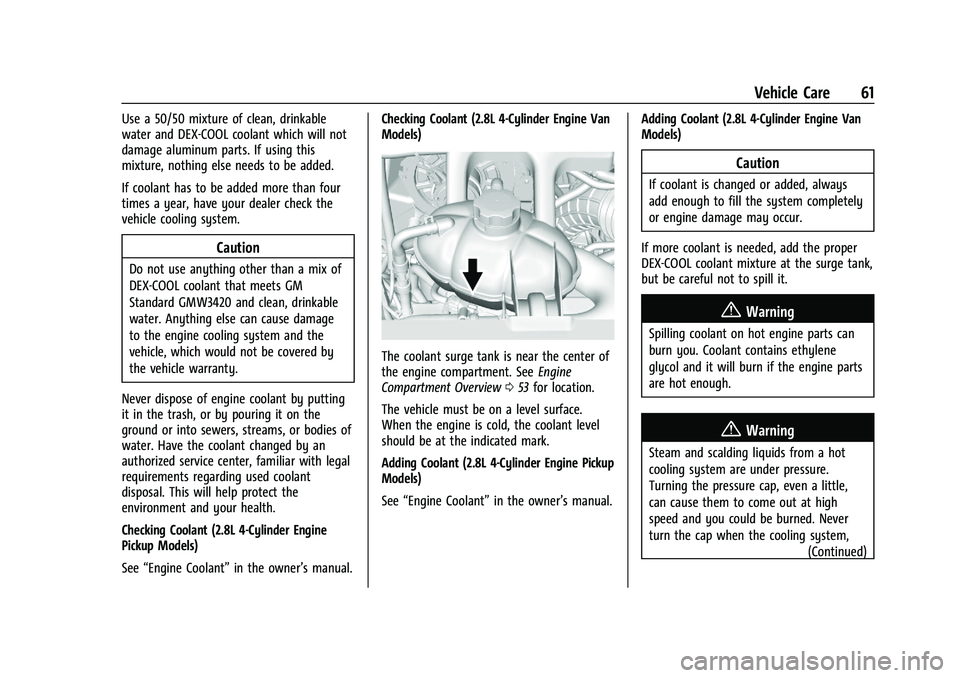
Chevrolet/GMC 2.8L Duramax Diesel Engine Supplement (GMNA-Localizing-
U.S./Canada-14465442) - 2021 - CRC - 2/3/20
Vehicle Care 61
Use a 50/50 mixture of clean, drinkable
water and DEX-COOL coolant which will not
damage aluminum parts. If using this
mixture, nothing else needs to be added.
If coolant has to be added more than four
times a year, have your dealer check the
vehicle cooling system.
Caution
Do not use anything other than a mix of
DEX-COOL coolant that meets GM
Standard GMW3420 and clean, drinkable
water. Anything else can cause damage
to the engine cooling system and the
vehicle, which would not be covered by
the vehicle warranty.
Never dispose of engine coolant by putting
it in the trash, or by pouring it on the
ground or into sewers, streams, or bodies of
water. Have the coolant changed by an
authorized service center, familiar with legal
requirements regarding used coolant
disposal. This will help protect the
environment and your health.
Checking Coolant (2.8L 4-Cylinder Engine
Pickup Models)
See “Engine Coolant” in the owner’s manual. Checking Coolant (2.8L 4-Cylinder Engine Van
Models)
The coolant surge tank is near the center of
the engine compartment. See
Engine
Compartment Overview 053 for location.
The vehicle must be on a level surface.
When the engine is cold, the coolant level
should be at the indicated mark.
Adding Coolant (2.8L 4-Cylinder Engine Pickup
Models)
See “Engine Coolant” in the owner’s manual. Adding Coolant (2.8L 4-Cylinder Engine Van
Models)
Caution
If coolant is changed or added, always
add enough to fill the system completely
or engine damage may occur.
If more coolant is needed, add the proper
DEX-COOL coolant mixture at the surge tank,
but be careful not to spill it.
{Warning
Spilling coolant on hot engine parts can
burn you. Coolant contains ethylene
glycol and it will burn if the engine parts
are hot enough.
{Warning
Steam and scalding liquids from a hot
cooling system are under pressure.
Turning the pressure cap, even a little,
can cause them to come out at high
speed and you could be burned. Never
turn the cap when the cooling system, (Continued)
Page 63 of 89
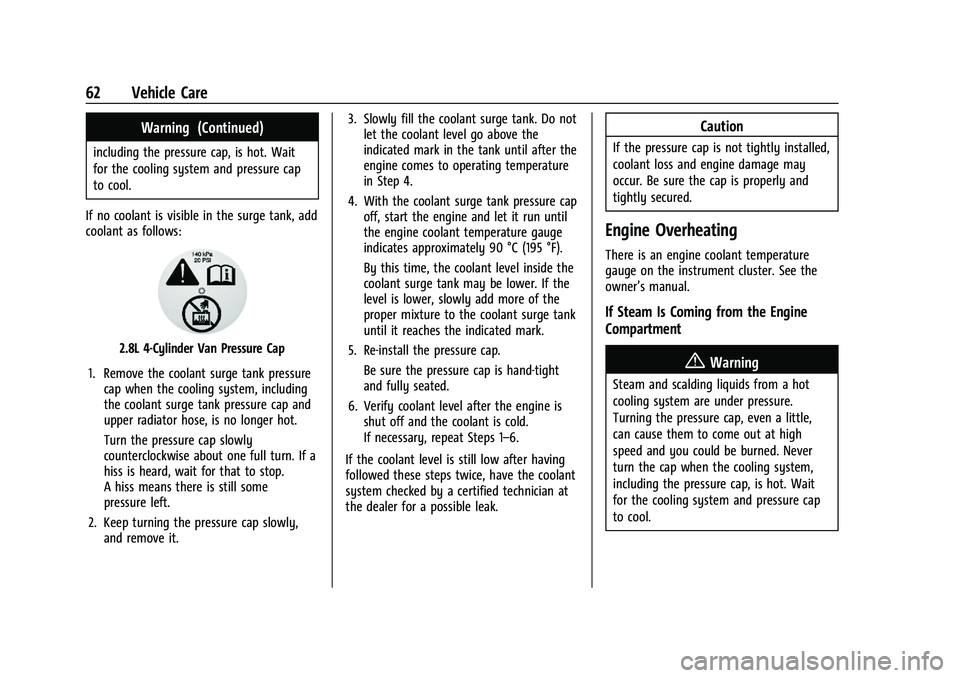
Chevrolet/GMC 2.8L Duramax Diesel Engine Supplement (GMNA-Localizing-
U.S./Canada-14465442) - 2021 - CRC - 2/3/20
62 Vehicle Care
Warning (Continued)
including the pressure cap, is hot. Wait
for the cooling system and pressure cap
to cool.
If no coolant is visible in the surge tank, add
coolant as follows:
2.8L 4-Cylinder Van Pressure Cap
1. Remove the coolant surge tank pressure cap when the cooling system, including
the coolant surge tank pressure cap and
upper radiator hose, is no longer hot.
Turn the pressure cap slowly
counterclockwise about one full turn. If a
hiss is heard, wait for that to stop.
A hiss means there is still some
pressure left.
2. Keep turning the pressure cap slowly, and remove it. 3. Slowly fill the coolant surge tank. Do not
let the coolant level go above the
indicated mark in the tank until after the
engine comes to operating temperature
in Step 4.
4. With the coolant surge tank pressure cap off, start the engine and let it run until
the engine coolant temperature gauge
indicates approximately 90 °C (195 °F).
By this time, the coolant level inside the
coolant surge tank may be lower. If the
level is lower, slowly add more of the
proper mixture to the coolant surge tank
until it reaches the indicated mark.
5. Re-install the pressure cap. Be sure the pressure cap is hand-tight
and fully seated.
6. Verify coolant level after the engine is shut off and the coolant is cold.
If necessary, repeat Steps 1–6.
If the coolant level is still low after having
followed these steps twice, have the coolant
system checked by a certified technician at
the dealer for a possible leak.
Caution
If the pressure cap is not tightly installed,
coolant loss and engine damage may
occur. Be sure the cap is properly and
tightly secured.
Engine Overheating
There is an engine coolant temperature
gauge on the instrument cluster. See the
owner’s manual.
If Steam Is Coming from the Engine
Compartment
{Warning
Steam and scalding liquids from a hot
cooling system are under pressure.
Turning the pressure cap, even a little,
can cause them to come out at high
speed and you could be burned. Never
turn the cap when the cooling system,
including the pressure cap, is hot. Wait
for the cooling system and pressure cap
to cool.
Page 64 of 89
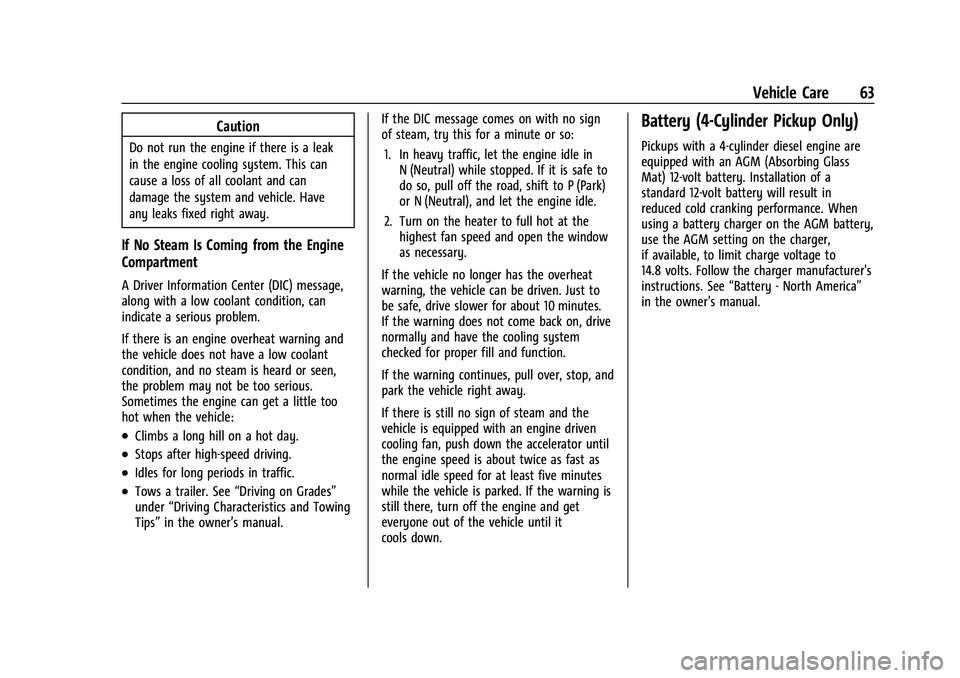
Chevrolet/GMC 2.8L Duramax Diesel Engine Supplement (GMNA-Localizing-
U.S./Canada-14465442) - 2021 - CRC - 2/3/20
Vehicle Care 63
Caution
Do not run the engine if there is a leak
in the engine cooling system. This can
cause a loss of all coolant and can
damage the system and vehicle. Have
any leaks fixed right away.
If No Steam Is Coming from the Engine
Compartment
A Driver Information Center (DIC) message,
along with a low coolant condition, can
indicate a serious problem.
If there is an engine overheat warning and
the vehicle does not have a low coolant
condition, and no steam is heard or seen,
the problem may not be too serious.
Sometimes the engine can get a little too
hot when the vehicle:
.Climbs a long hill on a hot day.
.Stops after high-speed driving.
.Idles for long periods in traffic.
.Tows a trailer. See“Driving on Grades”
under “Driving Characteristics and Towing
Tips” in the owner’s manual. If the DIC message comes on with no sign
of steam, try this for a minute or so:
1. In heavy traffic, let the engine idle in N (Neutral) while stopped. If it is safe to
do so, pull off the road, shift to P (Park)
or N (Neutral), and let the engine idle.
2. Turn on the heater to full hot at the highest fan speed and open the window
as necessary.
If the vehicle no longer has the overheat
warning, the vehicle can be driven. Just to
be safe, drive slower for about 10 minutes.
If the warning does not come back on, drive
normally and have the cooling system
checked for proper fill and function.
If the warning continues, pull over, stop, and
park the vehicle right away.
If there is still no sign of steam and the
vehicle is equipped with an engine driven
cooling fan, push down the accelerator until
the engine speed is about twice as fast as
normal idle speed for at least five minutes
while the vehicle is parked. If the warning is
still there, turn off the engine and get
everyone out of the vehicle until it
cools down.
Battery (4-Cylinder Pickup Only)
Pickups with a 4-cylinder diesel engine are
equipped with an AGM (Absorbing Glass
Mat) 12-volt battery. Installation of a
standard 12-volt battery will result in
reduced cold cranking performance. When
using a battery charger on the AGM battery,
use the AGM setting on the charger,
if available, to limit charge voltage to
14.8 volts. Follow the charger manufacturer's
instructions. See “Battery - North America”
in the owner’s manual.